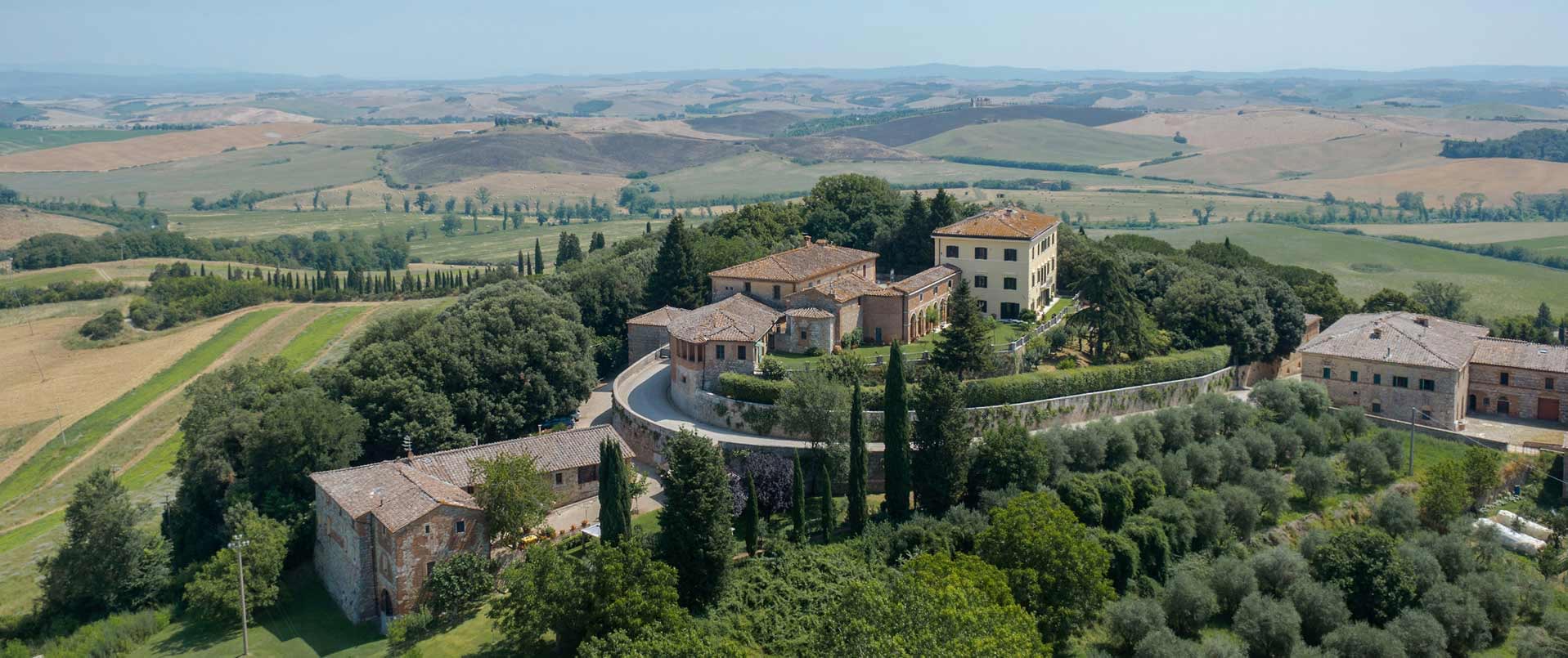
Villa Gattoni Cattaneo of Cornovecchio was built by Pietro Maria Gattoni in 1824, on the site of an old farmstead adjacent to the parish church. Pietro Maria Gattoni had made his fortune in the meat trade, supplying Napoleon’s army, and had bought properties in the Codogno district, firstly the estate of Cascinazza a Meleti (1779) and subsequently a second one in Cornovecchio (1804).
The Villa has a neoclassical French-style layout with a central body surmounted by a turret and two porticoed side wings that served as stables, storage for carriages, cottages and living quarters for the servants. A carving of a cat, the symbol of the Gattoni family (taken from the Italian ‘gatto’) is engraved in relief in the tympanum of the façade.
The garden at the front of the house served principally as the entrance point for carriages arriving at the property, while the main grounds were to be found at the rear of the building, fashioned in the English romantic style. Many of the trees were planted before the Villa was built. In particular, the two plane trees in the rear grounds are considered to be the tallest and oldest specimens in the Lombardy Region.
Pietro Maria Gattoni had two sons, Carlo Giuseppe and Leopoldo, to whom he bequeathed the two properties of Meleti and Cornovecchio by drawing lots. In this way the younger son, Leopoldo, unexpectedly inherited the land of Cornovecchio and the Villa into which he moved upon his father’s death in 1851, together with his wife Clementina Lamberti di Codogno, widow of Giuseppe Folli di Codogno. The older brother Carlo Giuseppe meanwhile went to live in Meleti, where he built his own residence in a large park.
Leopoldo was an important farmer and merchant and an influential member of the local nobility. Through his godson Cecco Folli he had met Gerolamo Induno, a patriot and painter at the time of the Risorgimento wars, and in 1852 he entrusted him with the task of decorating the entrance hall of the Villa which faced out onto the garden with frescoes. The oval centrepiece bears Induno’s signature and depicts a hunter from the Alps in Garibaldi’s army. There is a bust of Napoleon In the atrium, a copy of the one sculpted by Canova housed in the Capodimonte Museum in Naples, which is a tribute to the family’s good fortunes. Leopoldo’s other godson, Luigino Folli, was a friend of Felice Orsini, a revolutionary who supported Mazzini and who was Folli’s guest in Codogno on several occasions. It is said that Orsini was wounded while escaping from the prison in Mantua and spent a period of time hiding in the cellar of the house in Cornovecchio from where he left for London and then Paris to carry out the failed attempt to assassinate Napoleon III. After his capture, Orsini was executed.
Leopoldo Gattoni’s children were Carlo, who ran away from home at the age of eighteen to take part in the ‘Expedition of the Thousand’, as described in the ‘Campagna 1860’ Diary, Bortolo, who was also a supporter of Garibaldi, and who was the mayor of Codogno for several mandates, as well as being a member of the Lodi Provincial Council and a Senator of the Kingdom of Italy and Antonietta, who married Gaetano Cattaneo, a notary in Codogno. Their wedding was celebrated in the church of Cornovecchio.
Gaetano Cattaneo became the first mayor of Codogno after the Unification of Italy in 1861 and was introduced to Garibaldi during his first visit to Codogno by Marquis Giorgio Pallavicino di San Fiorano, his lieutenant in Naples. Garibaldi chose Cattaneo to be his notary when he drew up his will; it was subsequently modified several times and was the subject of vast amounts of correspondence involving a wealth of technical and legal references. The relationship between Garibaldi and Cattaneo was not purely professional but was also one of great friendship and esteem. One of the rooms of the Villa is dedicated to Garibaldi and contains a number of mementoes and memorabilia of the General, including two photographs of his house in Caprera.
The Villa was then inherited by his son Francesco, a notary like his father, who took over the shares of the Villa and the Fund from his uncles in the early 20th century, together with his wife Carmela Zazzera. It was during this period that the stained-glass windows that close the three arches leading to the atrium displaying Induno’s frescoes were created. Francesco and Carmela used to live in Codogno but would spend the autumn in Cornovecchio. This tradition was maintained over the years by their four children, and the Villa remained the centre for the whole family. The Villa and garden are protected by the Ministry of Culture and are registered with the Association of Italian Historical Residences (ADSI).
Staying in the villa’s guest quarters
Three independent apartments in the guest wing of the villa, called Le Magnolie, Il Pozzo and La Limonaia.
Guests have full use of the garden and swimming pool under the portico of the former barn, a small gym and fitness area, a recreation room and the hire of bicycles for excursions along the cycle paths in the area.
All three self-catering flats are fully furnished and equipped: they have a refrigerator, dishwasher, washing machine, air conditioning, fans and mosquito nets on the windows.
Le Magnolie: The apartment is about 150 square metres over two floors and sleeps 6. On the ground floor is the living/dining room and the kitchen. On the first floor there is a large living room with a fireplace, a study corner and a sofa bed, a large hallway leading into two bedrooms, both with twin beds, and the bathroom with a bathtub. It is possible to use part of the outside porch, which has a table, chairs and a barbecue.
Il Pozzo is about 120 square metres arranged over two floors, with 5 beds. On the ground floor, the entrance is a cosy room with a large fireplace and a sofa. Upstairs there is a living room with a study corner, a kitchen that can be closed off with a sliding glass door, a sofa bed and two bedrooms, one with a double bed and one with twin beds, and a bathroom with a bathtub. Likewise, it is possible to use part of the outside porch, with its table, chairs and barbecue.
La Limonaia: a renovated 110 sq.m. loft which used to be the old lemon house. It consists of an 80 sq.m. terracotta-tiled living room (respecting the original structure), with two beds at the rear of the room, plus a small kitchen area and a bathroom with a shower. The spiral staircase leads to the loft which contains twin beds. La Limonaia has exclusive use of an outdoor garden area of about 120 square metres overlooking the surrounding countryside, equipped with a table, chairs and deckchairs.
 Accommodation
Accommodation
 Co-Working
Co-Working
 Film sets
Film sets
 Gardens
Gardens
 Medium and long-term rentals
Medium and long-term rentals
 Parks
Parks
 Private events
Private events
 Residences
Residences
 Spirituality
Spirituality
 Visits
Visits
 Weddings
Weddings
 Cultural tourism
Cultural tourism  Cyclotourism
Cyclotourism  Excursions
Excursions  Gardens
Gardens  Hiking
Hiking  Historic Homes open to visitors
Historic Homes open to visitors  Nature
Nature  Sports
Sports  Walking itineraries
Walking itineraries